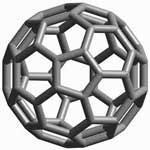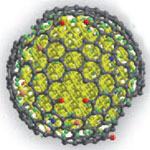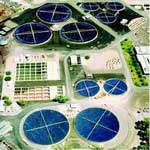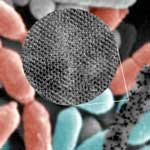Showing Spotlights 81 - 88 of 150 in category All (newest first):
 There is a general perception that nanotechnologies will have a significant impact on developing 'green' and 'clean' technologies with considerable environmental benefits. However, the environmental footprint created by today's nanomanufacturing technologies are conflicting with the general perception that nanotechnology environmentally benign. It actually appears that certain nanomaterial production technologies are quite dirty and also have a considerable energy footprint. Determining the full environmental impact of nanomaterials requires a full life cycle assessment. A recent paper takes a look at the material and energy intensity of fullerene production. It finds that the embodied energy of all fullerenes are an order of magnitude higher than most common chemicals.
There is a general perception that nanotechnologies will have a significant impact on developing 'green' and 'clean' technologies with considerable environmental benefits. However, the environmental footprint created by today's nanomanufacturing technologies are conflicting with the general perception that nanotechnology environmentally benign. It actually appears that certain nanomaterial production technologies are quite dirty and also have a considerable energy footprint. Determining the full environmental impact of nanomaterials requires a full life cycle assessment. A recent paper takes a look at the material and energy intensity of fullerene production. It finds that the embodied energy of all fullerenes are an order of magnitude higher than most common chemicals.
Apr 20th, 2011
 The recent oil spill in the Gulf of Mexico is widely acknowledged to be among the worst ocean oil spills in world history. Inevitably, the spill has once again raised serious concerns worldwide about the likely environmental impact of such catastrophic oil spills caused by oil tanker accidents at sea or mishaps during loading and unloading of oil from tankers at seaports. Numerous solutions have been proposed for dealing with the problem of oil spills. Conventional techniques are not adequate to solve the problem of massive oil spills. In recent years, nanotechnology has emerged as a potential source of novel solutions to many of the world's outstanding problems. Although the application of nanotechnology for oil spill cleanup is still in its nascent stage, there has been particularly growing interest in exploring ways of finding suitable solutions to clean up oil spills through use of nanomaterials.
The recent oil spill in the Gulf of Mexico is widely acknowledged to be among the worst ocean oil spills in world history. Inevitably, the spill has once again raised serious concerns worldwide about the likely environmental impact of such catastrophic oil spills caused by oil tanker accidents at sea or mishaps during loading and unloading of oil from tankers at seaports. Numerous solutions have been proposed for dealing with the problem of oil spills. Conventional techniques are not adequate to solve the problem of massive oil spills. In recent years, nanotechnology has emerged as a potential source of novel solutions to many of the world's outstanding problems. Although the application of nanotechnology for oil spill cleanup is still in its nascent stage, there has been particularly growing interest in exploring ways of finding suitable solutions to clean up oil spills through use of nanomaterials.
Feb 21st, 2011
 Global warming, caused by a build-up of greenhouse gases, in particular carbon dioxide, in the atmosphere, has led to numerous proposals on how to capture and store CO2 in order to mitigate the damaging emissions from fossil fuels. Today we take a look at carbon sequestration and subsequent storage in geological formations (geosequestration) - a proposal that is already being tested on a large scale. The idea behind coal-bed geosequestration is that you inject a huge amount of carbon dioxide into deep unmined coal seams. Due to strong adsorption forces, the carbon dioxide will be adsorbed in coal. It will not be desorbed and gradually transform to solid rocks. Moreover the technology is already developed and in use for oil and gas mining. However, the fundamental problem is so-called adsorption-induced deformation of coal or any other porous material.
Global warming, caused by a build-up of greenhouse gases, in particular carbon dioxide, in the atmosphere, has led to numerous proposals on how to capture and store CO2 in order to mitigate the damaging emissions from fossil fuels. Today we take a look at carbon sequestration and subsequent storage in geological formations (geosequestration) - a proposal that is already being tested on a large scale. The idea behind coal-bed geosequestration is that you inject a huge amount of carbon dioxide into deep unmined coal seams. Due to strong adsorption forces, the carbon dioxide will be adsorbed in coal. It will not be desorbed and gradually transform to solid rocks. Moreover the technology is already developed and in use for oil and gas mining. However, the fundamental problem is so-called adsorption-induced deformation of coal or any other porous material.
Nov 30th, 2010
 Friends of the Earth have just published a new report titled 'Nanotechnology, climate and energy: over-heated promises and hot air?' As usual, the 'good cop, bad cop' team that writes this kind of document was at its best again. On one hand, there is a lot of really good information in this report, well researched and referenced, and it provides a very useful overview of what's going on in nanotechnology research and development in the climate/renewables fields - albeit with a very negative spin on it. On the other hand, there seems to be a monkey sitting on each FoE editor's shoulder that constantly whispers 'Are you kidding me? Boooring! Too positive! Too balanced! Not scary enough! Traitor - think of all the drowning polar bears!' We look at some of the misconceptions in FoE's report.
Friends of the Earth have just published a new report titled 'Nanotechnology, climate and energy: over-heated promises and hot air?' As usual, the 'good cop, bad cop' team that writes this kind of document was at its best again. On one hand, there is a lot of really good information in this report, well researched and referenced, and it provides a very useful overview of what's going on in nanotechnology research and development in the climate/renewables fields - albeit with a very negative spin on it. On the other hand, there seems to be a monkey sitting on each FoE editor's shoulder that constantly whispers 'Are you kidding me? Boooring! Too positive! Too balanced! Not scary enough! Traitor - think of all the drowning polar bears!' We look at some of the misconceptions in FoE's report.
Nov 18th, 2010
 A relatively new method of purifying brackish water is capacitive deionization (CDI) technology. The advantages of CDI are that it has no secondary pollution, is cost-effective and energy efficient. The basic concept of CDI, as well as electrosorption, is to force charged ions toward oppositely polarized electrodes through imposing a direct electric field: brackish water flows between pairs of high surface area carbon electrodes that are held at a potential difference of about 1-2 volts. The ions and other charged particles, such as microorganisms, are attracted to and held on the electrode of opposite charge. A research team has now developed a CDI application that uses graphene-like nanoflakes as electrodes for capacitive deionization. They found that the graphene electrodes resulted in a better CDI performance than the conventionally used activated carbon materials.
A relatively new method of purifying brackish water is capacitive deionization (CDI) technology. The advantages of CDI are that it has no secondary pollution, is cost-effective and energy efficient. The basic concept of CDI, as well as electrosorption, is to force charged ions toward oppositely polarized electrodes through imposing a direct electric field: brackish water flows between pairs of high surface area carbon electrodes that are held at a potential difference of about 1-2 volts. The ions and other charged particles, such as microorganisms, are attracted to and held on the electrode of opposite charge. A research team has now developed a CDI application that uses graphene-like nanoflakes as electrodes for capacitive deionization. They found that the graphene electrodes resulted in a better CDI performance than the conventionally used activated carbon materials.
Oct 27th, 2010
 Catalytic dehydrogenation of ethylbenzene is one of the most important processes in the chemical industry world-wide. Styrene, for instance, is commonly produced using this process. The annual production of some 20 million metric tonnes of styrene is an important precursor in the plastics industry. Being able to develop a new metal-free, energy-saving, and efficient catalyst for alkane dehydrogenation would have a significant positive impact on the environment. Coke formation during the current industrial process is the main disadvantage of the metal-based catalysts now used. Steam is used as a protection agent to avoid coking and thus keep the catalysts active. The steam generation consumes massive amounts of energy. This is simply solved by using carbon as catalyst material. Even without steam, the catalyst is free from coke formation and shows long time stability. Researchers have now developed a new process for the dehydrogenation of ethylbenzene, using nanodiamonds as catalyst, that is oxygen-free and steam-free.
Catalytic dehydrogenation of ethylbenzene is one of the most important processes in the chemical industry world-wide. Styrene, for instance, is commonly produced using this process. The annual production of some 20 million metric tonnes of styrene is an important precursor in the plastics industry. Being able to develop a new metal-free, energy-saving, and efficient catalyst for alkane dehydrogenation would have a significant positive impact on the environment. Coke formation during the current industrial process is the main disadvantage of the metal-based catalysts now used. Steam is used as a protection agent to avoid coking and thus keep the catalysts active. The steam generation consumes massive amounts of energy. This is simply solved by using carbon as catalyst material. Even without steam, the catalyst is free from coke formation and shows long time stability. Researchers have now developed a new process for the dehydrogenation of ethylbenzene, using nanodiamonds as catalyst, that is oxygen-free and steam-free.
Oct 18th, 2010
 Silver nanoparticles are one of the most extensively used type of nanoparticles in consumer products due to the unique antibacterial activity of silver. There have been raising environmental concerns over their adverse ecological effects, along with ionic silver potentially released from the particles. To predict the environmental impact of engineered silver nanoparticles, their characterization from environmental matrices should be pursued, yet no field-scale studies are available to date. A new research report was motivated by the fact that silver nanoparticles in consumer products are likely being released during and/or after the product's lifetime. The silver nanoparticles will likely get into wastewater streams and subsequently enter wastewater treatment plants. During wastewater treatment processes, silver nanoparticles may be incorporated into the sewage sludge matrix and concentrated over time.
Silver nanoparticles are one of the most extensively used type of nanoparticles in consumer products due to the unique antibacterial activity of silver. There have been raising environmental concerns over their adverse ecological effects, along with ionic silver potentially released from the particles. To predict the environmental impact of engineered silver nanoparticles, their characterization from environmental matrices should be pursued, yet no field-scale studies are available to date. A new research report was motivated by the fact that silver nanoparticles in consumer products are likely being released during and/or after the product's lifetime. The silver nanoparticles will likely get into wastewater streams and subsequently enter wastewater treatment plants. During wastewater treatment processes, silver nanoparticles may be incorporated into the sewage sludge matrix and concentrated over time.
Oct 4th, 2010
 In nature, uni- and multicellular organisms are capable of reducing and accumulating metal ions as detoxification and homeostasis mechanisms when exposed to metal ion solutions. Although the exact mechanisms and identities of microbial proteins associated for metal nanoparticle synthesis are not clear, two cysteine-rich, heavy metal-binding biomolecules, phytochelatin and metallothionein have been relatively well characterized. Phytochelatins are peptides that are synthesized by the protein phytochelatin synthase and that can form metal complexes with cadmium, copper, silver, lead and mercury, while metallothioneins are gene-encoded proteins capable of directly binding metals such as copper, cadmium, and zinc. This capability of phytochelatin and metallothionein - having different metal binding affinities to various metal ions - has now been employed by researchers for the in vivo biosynthesis of metal nanoparticles by recombinant Escherichia coli.
In nature, uni- and multicellular organisms are capable of reducing and accumulating metal ions as detoxification and homeostasis mechanisms when exposed to metal ion solutions. Although the exact mechanisms and identities of microbial proteins associated for metal nanoparticle synthesis are not clear, two cysteine-rich, heavy metal-binding biomolecules, phytochelatin and metallothionein have been relatively well characterized. Phytochelatins are peptides that are synthesized by the protein phytochelatin synthase and that can form metal complexes with cadmium, copper, silver, lead and mercury, while metallothioneins are gene-encoded proteins capable of directly binding metals such as copper, cadmium, and zinc. This capability of phytochelatin and metallothionein - having different metal binding affinities to various metal ions - has now been employed by researchers for the in vivo biosynthesis of metal nanoparticles by recombinant Escherichia coli.
Sep 24th, 2010
 There is a general perception that nanotechnologies will have a significant impact on developing 'green' and 'clean' technologies with considerable environmental benefits. However, the environmental footprint created by today's nanomanufacturing technologies are conflicting with the general perception that nanotechnology environmentally benign. It actually appears that certain nanomaterial production technologies are quite dirty and also have a considerable energy footprint. Determining the full environmental impact of nanomaterials requires a full life cycle assessment. A recent paper takes a look at the material and energy intensity of fullerene production. It finds that the embodied energy of all fullerenes are an order of magnitude higher than most common chemicals.
There is a general perception that nanotechnologies will have a significant impact on developing 'green' and 'clean' technologies with considerable environmental benefits. However, the environmental footprint created by today's nanomanufacturing technologies are conflicting with the general perception that nanotechnology environmentally benign. It actually appears that certain nanomaterial production technologies are quite dirty and also have a considerable energy footprint. Determining the full environmental impact of nanomaterials requires a full life cycle assessment. A recent paper takes a look at the material and energy intensity of fullerene production. It finds that the embodied energy of all fullerenes are an order of magnitude higher than most common chemicals.
 Subscribe to our Nanotechnology Spotlight feed
Subscribe to our Nanotechnology Spotlight feed





